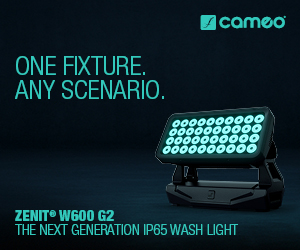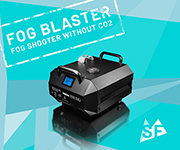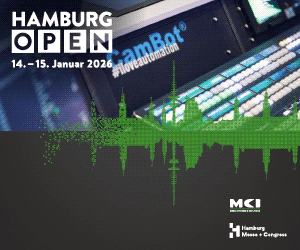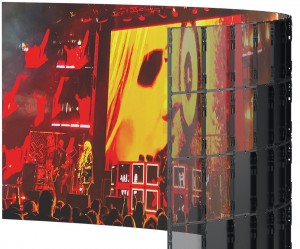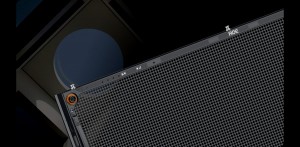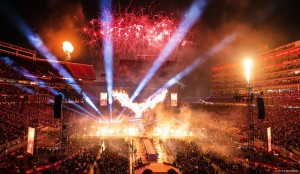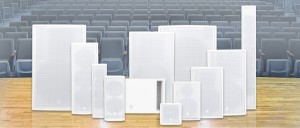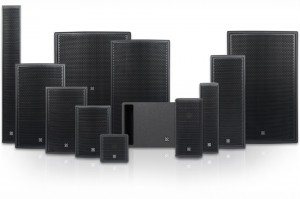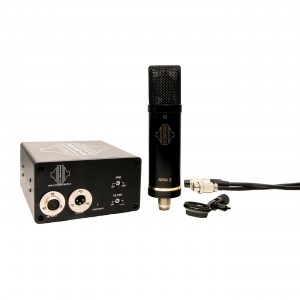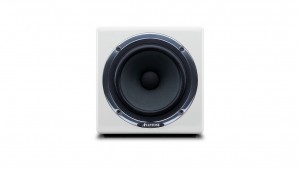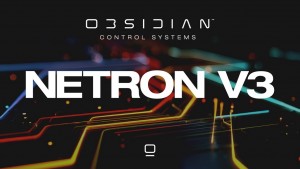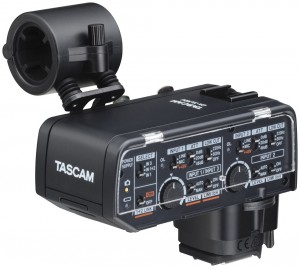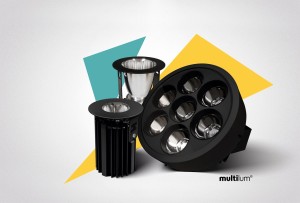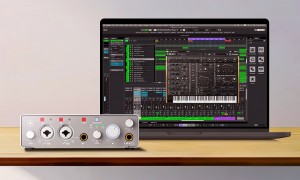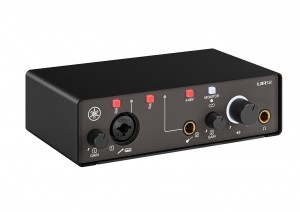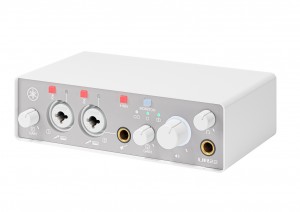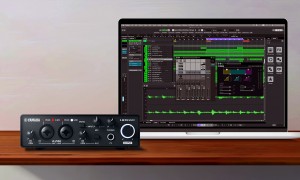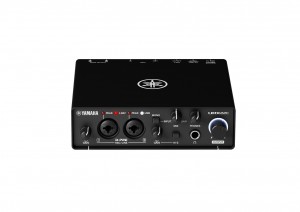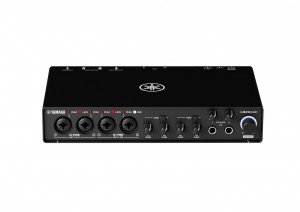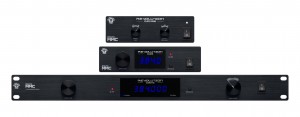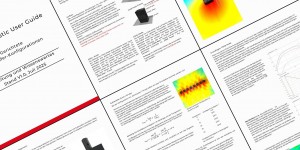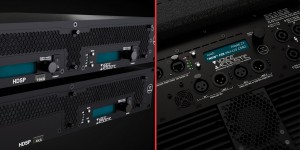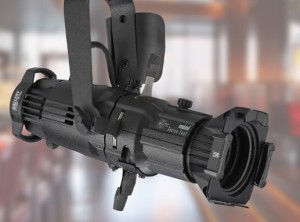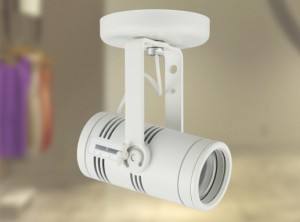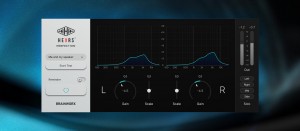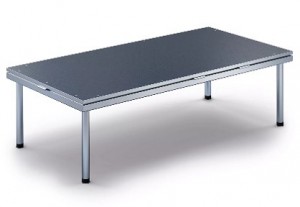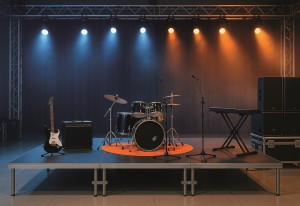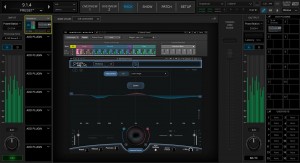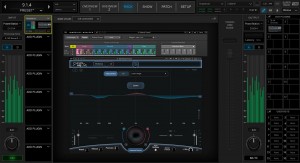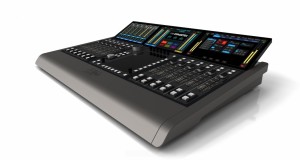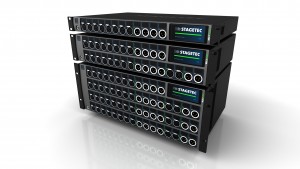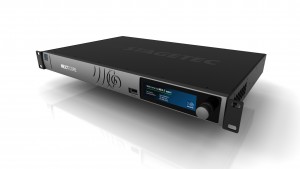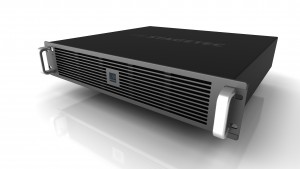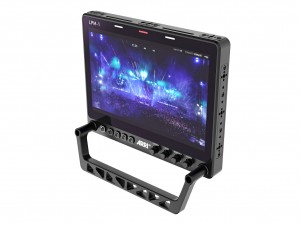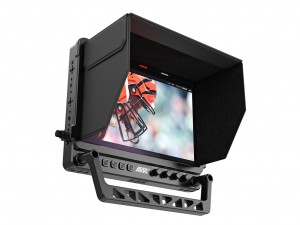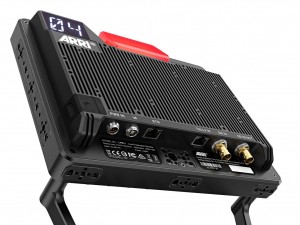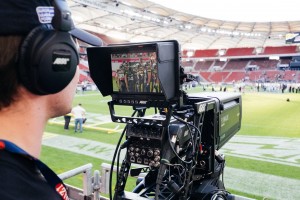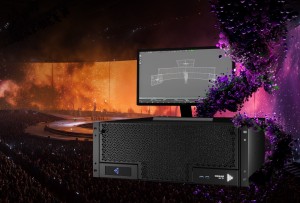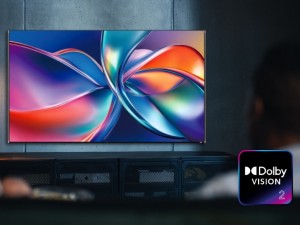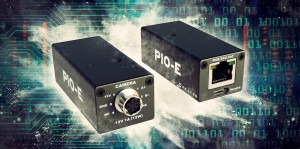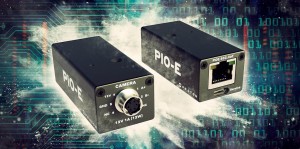Equipment News
Equipment News Schlagzeilen
ROE Visual launches Vanish Air Rental
08/12/2025
Obsidian introduces Netron V3
29/10/2025
Stagetec unveils new products
12/09/2025
Lawo stellt Home-Audio-Shuffler-App vor
11/09/2025
Disguise unveils GX 3+ media server
03/09/2025
Dolby präsentiert Dolby Vision 2
02/09/2025
Proton introduces new control interface
27/08/2025
Avolites launches new range of D3 consoles
27/08/2025
ROE Visual launches Vanish Air Rental
ROE Visual has announced the release of Vanish Air Rental, the latest addition to its Vanish series. Engineered to address key structural and visual challenges in the transparent LED market, Vanish Air Rental introduces an innovative design that integrates the power system directly into a slim frame, bringing the LED panel’s visual transparency to 92 percent, thereby enhancing light transmission and on stage sound permeability.
Developed as a 1000 x 1000 mm platform, Vanish Air Rental is the first rental LED panel to deliver and distribute power through the panel frame, eliminating the need for a conventional central PSU column. It also replaces the traditional grille-style LED layout with a refined perforated LED design. Because the human eye visually blends fine high-frequency details, the tiny perforations fade from perception as distance increases. Seen from a distance of 5-8 meters, the panel’s structural components visually disappear.
Vanish Air Rental offers a 6.94 mm pixel pitch and brightness levels of up 4000 nits. The panel incorporates black LEDs, dark GOB technology, and a clean PCB layout, enhancing its contrast ratio and resulting in a pure, high-fidelity image. Vanish Air Rental’s design is flexible - it can curve up to 5°, and for projects that require a non-transparent display, an optional blanking plate can be mounted to the rear of the panel. This transforms the screen from transparent to solid, offering a dual-purpose solution.
“When we started to develop Vanish Air Rental, we approached transparency from a completely new perspective, not just at the LED level, but across every structural and electronic detail”, says Glory Gao, Product Department Director at ROE Visual. “Through a combination of optical, mechanical, and aesthetic refinements, we have developed Vanish Air Rental as a transparent LED panel that performs at a higher level in every aspect.”
(Photos: ROE Visual)
GLP Mad Maxx nach IP66-Zertifizierung für Tourneen und Festinstallationen geeignet
Zum Ende einer ereignisreichen Open-Air-Saison verbucht GLP die Entscheidung, den Wetterschutz seines Mad-Maxx-CW-LED-Fatbeams/Skytrackers von IP65 auf die noch robustere Schutzklasse IP66 anzuheben, nach eigenen Angaben als „vollen Erfolg“.
Der Scheinwerfer mit 750 mm breitem Lichtaustritt und einer maximalen Lichtleistung von 68.000 Lumen war in diesem Sommer bereits weltweit bei zahlreichen Outdoor-Produktionen im Einsatz. Für Mark Ravenhill (Director GLP US) reicht die neue Zertifizierung noch weiter: „Mit der IP66-Klassifizierung ist der Mad Maxx nun auch für den dauerhaften Außeneinsatz geeignet“, erklärt er. Ein prominentes Beispiel dafür ist die Festinstallation in der 20.000 Personen fassenden Rocket Arena in Cleveland (USA).
Auch auf aktuellen Open-Air-Tourneen in Nordamerika - darunter die von The Weeknd (Lichtdesign: Jason Baeri) und Maná (Lichtdesign: Iggy Rosenberg) - kommt der Mad Maxx CW zum Einsatz. In Deutschland war er jüngst auf dem Wacken Open Air 2025 und dem Parookaville Festival zu sehen (Lichtdesign: Jerry Appelt), jeweils mit 24 Einheiten. In Österreich setzte Appelt das Movinglight zudem beim Sommernachtskonzert der Wiener Philharmoniker ein, um die Fassade des Schlosses Schönbrunn zu illuminieren.
Fotos: Mad Maxx CW im Einsatz für Parookaville und The Weeknd. (Fotocredits: Amy Haghebaert/Steve Jennings/Lupixx/Parookaville)
Black Lion Audio macht professionelles Power Conditioning mobil
Mit dem PG-P Plus Type F von Black Lion Audio können nun auch reisende Musiker die Stromreinigung des US-amerikanischen Herstellers nutzen. Der kompakte Power Conditioner bringt damit die aus Tonstudios bekannte Stromversorgung auf die Bühne. Acht Schuko-Steckdosen versorgen Musikinstrumente und Geräte mit gereinigtem Strom und gewährleisten darüber hinaus einen Überspannungsschutz.
Zwei USB-Ladebuchsen, ein zentraler Power-Schalter und praxisorientierte Kontroll-Anzeigen machen den PG-P Plus Type F zu einer universell einsetzbaren mobilen Versorgungslösung. Die Kondensatoren wurden speziell auf ideale Hochfrequenz-Filtereigenschaften hin selektiert. Einstreuungen von Schaltnetzteilen, Computern und Mobilgeräten werden effektiv unterdrückt. Der PG-P Plus Type F verfügt über die gleiche Filtertechnologie wie das Flaggschiff PG-2 Type F und erreicht laut Hersteller eine dreimal effizientere Filterung als Konkurrenzprodukte der gleichen Preisklasse.
Die LED-Anzeige des PG-P Plus Type F gibt Auskunft über die aktuell anliegende Netzspannung, drei weitere Kontroll-Leuchten informieren über die aktive Stromreinigung, eine korrekte Masseverbindung sowie den Status des Überspannungsschutzes. So ist das Gerät auch bei einer eventuell notwendigen Fehlersuche im System hilfreich.
Mit seinem robusten schwarzen Metallgehäuse ist der PG-P Plus Type F für den Einsatz auf Tourneen gerüstet. Die acht Schuko-Steckdosen befinden sich wie die USB-Anschlüsse, der Powerschalter und die Betriebszustands-Anzeigen auf der Oberseite. Die versenkten Gummifüße gewährleisten stabilen Halt, gleichzeitig bietet der PG-P Plus Type F Montagemöglichkeiten über Klettbänder oder Verschraubungen. Das Anschlusskabel ist laut Hersteller ebenfalls roadtauglich.
Der PG-P Plus Type F wird in Deutschland, Österreich und der Schweiz von Audiowerk vertrieben und ist voraussichtlich ab Mitte Dezember 2025 verfügbar.
(Foto: Black Lion Audio/Audiowerk)
Crest Audio CPL+ loudspeaker line receives full EASE and CLF2 integration
Crest Audio, a division of Peavey Commercial Audio, has expanded the capabilities of its latest CPL+ loudspeaker series with full support for EASE (Enhanced Acoustic Simulator for Engineers) and CLF2 (Common Loudspeaker Format) data integration. The move gives AV consultants, system designers, and integrators direct access to manufacturer-verified loudspeaker data for use in predictive acoustic modelling, coverage mapping, and design validation.
The CPL+ range combines tour-grade components, robust cabinetry, and refined voicing to deliver high output, clarity, and reliability in demanding environments. Designed for both fixed installation and mobile reinforcement, the series includes a family of full-range and subwoofer models, offering coverage and configuration options for a variety of applications - from live music venues and auditoriums to corporate AV systems, educational spaces, and leisure environments.
Now EASE- and CLF2-enabled, each CPL+ loudspeaker ships with comprehensive GLL and CF2 data files, allowing users to perform detailed design simulations within EASE 5, EASE 4, and CLF Viewer, as well as most CLF compatible simulation software, providing 3D balloon and polar plots for precise directivity analysis, frequency response and phase plots validated to industry standards, comparative overlays to match CPL+ models against other manufacturers, and accurate SPL coverage and STI mapping when deployed in EASE-modelled venues.
The CPL+ range includes six two-way full-range, two coax, and two column array enclosures, featuring low-frequency drivers paired with a high-frequency driver. Offering a choice of constant-directivity horns or, with selected models, rotatable horns, the series provides pattern control for coverage in any environment.
Completing the lineup, a choice of subwoofers deliver low-frequency performance with extended depth. All models are designed with flying, pole-mount, and bracket-mount options that make them equally at home in permanent installations or portable sound applications. All enclosures in the range are available in a tough black or white finish, featuring birch plywood construction and integrated rigging points.
(Photos: Peavey Commercial Audio)
Sontronics präsentiert neues Großmembran-Röhrenmikrofon
Der britische Hersteller Sontronics hat das Konzept seines Röhren-Großmembran-Kondensatormikrofons Aria für das neue Modell Aria 2 verfeinert. Herzstück des Aria 2 ist die speziell für dieses Mikrofon entwickelte 34-mm-Goldsputter-Kapsel, die Verbindung mit der Röhrentechnologie ein spezielles Klangbild ermöglicht.
Das Mikrofon fängt sowohl Stimmen als auch akustische Instrumente ein und sorgt mit subtiler Kompression für den gewünschten Sitz im Mix. Die hohe Polarisationsspannung der Kondensatorkapsel ermöglicht höhere Empfindlichkeit und zugleich geringeres Eigenrauschen. Mit einem maximalen Grenzschalldruck von 135 dB ist das Aria 2 zudem für pegelstarke Instrumente geeignet, etwa bei Schlagzeugaufnahmen.
Für die Verstärkerschaltung kommt eine 12AX7/ECC83S-Röhre aus europäischer Fertigung zum Einsatz. Die notwendige Versorgungsspannung besorgt das mitgelieferte Netzteil über eine achtpolige Leitung. Das Aria 2 wird in England von Hand gefertigt. Der Hersteller gewährt eine lebenslange Garantie.
Das Sontronics Aria 2 wird in Deutschland und der Schweiz von Audiowerk vertrieben. Es ist ab sofort im Fachhandel verfügbar.
(Foto: Sontronics/Audiowerk)
Avantone Pro veröffentlicht Active Mixcubes White
Avantone Pro erweitert seine Mixcube-Referenzmonitor-Serie um die Active Mixcubes White. Die ersten Mixcubes von Avantone Pro kamen vor gut zwei Jahrzehnten auf den Markt. Damals noch als passive Version, vermittelten die Würfellautsprecher Tonschaffenden mit Single-Treiber-Konfiguration und eingeschränktem Frequenzgang einen authentischen Eindruck der Klangabbildung von Alltagsgeräten.
Die neuen Active Mixcubes White bauen als aktive Variante auf dem Vermächtnis der passiven Vorgänger auf, angetrieben von einem 60-Watt-A/B-Verstärker. Der 5,25-Zoll-Treiber mit Papier-/Mica-Membran ist in einen Aluminiumgussrahmen eingebettet und sorgt für eine verzerrungsarme Frequenzwiedergabe von 200 Hz bis 10 kHz - dem Frequenzbereich, den unter anderem Smartphone- und TV-Lautsprecher, Laptops sowie kleine Bluetooth-Boxen wiedergeben.
Das weiße MDF-Gehäuse ist mit Dacron-Dämmmaterial ausgekleidet, um unerwünschte Resonanzen zu minimieren. Mittels rutschfester Neopren-Auflage, 5/8-Zoll-Stativgewinde und kombinierten XLR/TRS-Eingängen sind die Mini-Referenzlautsprecher mit jeder Studiokonfiguration kompatibel, sowohl als Mono- als auch als Stereo-Setup. Die Abmessungen betragen 165 x 199,5 x 171 mm (B x T x H).
Die Active Mixcubes White werden in Deutschland, Österreich und der Schweiz von Audiowerk vertrieben und sind voraussichtlich ab Mitte Dezember 2025 verfügbar.
(Foto: Avantone Pro/Audiowerk)
Obsidian introduces Netron V3
Obsidian Control Systems has released Netron V3, the third major update to its Netron data distribution platform for entertainment. Netron V3 delivers enhanced protocols, improved stability, and new management tools to simplify deployment for concerts, live events, film, and permanent installations.
“With Netron V3, we’re providing lighting professionals with a future-proof ecosystem that streamlines setup, enhances performance, and adapts to every application”, says Koy Neminathan, Business Development Director at Obsidian Control Systems. “With V3, we’ve taken a major step forward by unifying every device under one consistent platform. It includes smarter features and a host of user-requested improvements from lighting professionals worldwide.”
As the latest firmware update for all of Netron’s EtherDMX nodes, Netron V3 unifies the entire line under one consistent platform. With improved protocol support, advanced device monitoring, and centralized management through the Netron Central Utility (CLU), V3 aims to make every system more stable, reliable, and easier to manage.
Enhancements with V3 include: a unified platform (consistent functions and menu layouts across all Netron devices allow for faster setup and intuitive operation), smarter features (improved protocols keep data flowing smoothly with greater reliability and control while implementing the most requested tools from lighting professionals), simplified management (update, monitor, and troubleshoot devices more easily via CLU for less downtime and smoother-running shows), and enhanced reliability (fixes bugs and improves stability across the line).
Netron V3 also supports the recent expansion into integrator-friendly products and solutions for permanent installations. With an IP66-rated line of signal devices also available, Netron now offers one of the widest ranges of data distribution products on the market. Users can upgrade to Netron V3 by downloading the latest version of Netron CLU at https://www.obsidiancontrol.com/collections/utilities.
(Photo: Obsidian Control Systems)
Digitaler Mikrofonadapter von Tascam für Nikon ZR erhältlich
Bislang konnten Nikon-Kameras externe Audiosignale nur über eine Analogverbindung entgegennehmen. Tascam stellt nun mit dem Nikon-Kit CA-XLR2d-N eine weitere Variante seines XLR-Mikrofonadapters vor, die den Ton in professioneller Qualität digital über den Zubehörschuh an die spiegellose Nikon ZR überträgt.
Der CA-XLR2d soll die Lücke zwischen professionellem Ton und modernen Video-Workflows schließen und komplexe Synchronisationsaufgaben in der Postproduktion überflüssig machen. Mittels der HDDA-Mikrofonvorverstärker von Tascam sollen Kreative in einer Vielzahl von Filmszenarien saubere, rauschfreie Aufnahmen mit großem Dynamikumfang erzielen.
Mit zwei XLR/TRS-Kombibuchsen und einer Mini-Klinkenbuchse lassen sich Richtrohr- und Kondensatormikrofone genauso wie Lavaliermikrofone und Line-Pegel-Quellen mit der Kamera nutzen. Die A/D-Wandler übertragen das Audiosignal digital über den Zubehörschuh und beziehen ihre Stromversorgung aus dem Kameragehäuse.
Zudem gibt es einen Kopfhörerausgang für das Monitoring, eine integrierte stoßgedämpfte Mikrofonhalterung und einen Analogausgang. Verarbeitungsfunktionen wie Auto-Pegel, Tiefenabsenkung und Limiter sollen Content-Ersteller, Dokumentarfilmer und andere Nutzer auch bei anspruchsvollen Aufgaben unterstützen.
(Foto: Tascam)
Multisenses präsentiert eigene Leuchten-Marke
Die Multisenses GmbH aus Lage hat sich auf die LED-Umrüstung, auf Beleuchtungstechnik und die Integration von Steuerungstechnik spezialisiert. Im Rahmen dieser Tätigkeit hat sich im Laufe der Jahre ein Anforderungskatalog an Leuchten entwickelt, den das Team um Geschäftsführer Christoph Grauting zum Anlass nahm, eine eigene Marke zu konzipieren: Multilum.
„Mit unserer bisherigen Erfahrung in der LED-Umrüstung wollten wir unser Portfolio schon immer um eigene Produkte ergänzen“, sagt Grauting. „So haben wir besonders den Fokus auf hochwertige Reflektoren und LED-Chips gelegt. Multilum ist projektbezogen individualisierbar und bietet eine hohe Farbwiedergabe. Wir sind stolz darauf, unsere bislang drei Multilum-Serien präsentieren zu dürfen und arbeiten schon an weiteren Ausführungen.“
(Foto: Multisenses GmbH)
Yamaha launches UR-mk3 and URX-C recording and streaming audio interfaces
Yamaha has launched four new audio interfaces, as it announces the rebranding of the UR series - previously offered under the Steinberg banner - as Yamaha products. The new Yamaha UR-mk3 and URX-C interfaces inherit the features of the Steinberg UR series to provide creators with solutions for music production and streaming.
The UR12mk3 and UR22mk3 provide a compact package for beginners. The interface features a UR microphone preamp which supports 24-bit/192 kHz high resolution recording, a compact design for easy portability and intuitive level adjustment controls, as well as front panel monitor and mute options.
They come bundled with Steinberg Cubase AI music production software, for multi-track recording and editing, free sound expansion and effects with Steinberg Plus, as well as the MixKey software for streaming applications.
Available in black or white finish, UR-mk3 interfaces support every step of the creative process, such as capturing vocals and instruments, creating and enhancing tracks, and broadcasting live performances in real time.
The URX22C and URX44C interfaces offer a solution for novice and intermediate users’ recordings and live streamings, featuring comprehensive mixing capabilities powered by Yamaha’s custom DSP, along with effect and volume control via the free dspMixFx app.
The interfaces deliver professional quality sound, due to Yamaha’s D-Pre mic preamps and 32-bit/192 kHz audio resolution. Additionally, intuitive virtual operation is complemented by a simplified physical architecture, featuring dual headphone outputs for monitoring separate mixes, independent headphone and master volume controls, plus close integration with an optional Elgato Stream Deck controller.
The seamless expansion of audio and mixing functions enables users to switch between capturing, producing and sharing their content.
The new audio interfaces are available immediately.
(Photos: Yamaha)
Black Lion Audio präsentiert neue Studio-Clocks
Black Lion Audio stellt drei neue Studio-Clocks vor: Revolution Clock, Revolution Clock XC und Revolution Clock Mini. Die Clocks basieren auf der patentierten Macro-MMC-Technologie von Black Lion.
Eine zentrale Clock stellt sicher, dass alle in einem System verbundenen digitalen Komponenten nach dem gleichen Takt arbeiten, um Jitter-Probleme zu vermeiden. Statt eines Quarzoszillators nutzt Black Lion bei den Clocks der Revolution-Serie MEMS-Oszillatoren. Zudem kommen Mini-Übertrager zum Einsatz, die für eine galvanische Trennung sorgen und Interferenzen minimieren.
Die Revolution Clock liefert ihren Präzisionstakt an bis zu sieben Geräte. Dafür bietet sie vier BNC-Outputs sowie Anschlussmöglichkeiten über S/PDIF, ADAT (optisch) und AES/EBU. Die Sampling-Rate lässt sich über einen Drehregler auf der Front von 44,1 kHz bis 384 kHz wählen. Um Fehlbedienungen zu vermeiden, wird der Drehregler nach drei Sekunden gesperrt - so besteht nicht die Gefahr, dass im Betrieb oder während der Aufnahme versehentlich die Sampling-Rate umgestellt wird.
Für kleinere Studios bietet Black Lion die Revolution Clock Mini. Das ultrakompakte Format liefert denselben Präzisionstakt wie die größeren Geschwister an bis zu drei Geräte per BNC. Die Sampling-Rate kann auf der Front über zwei Drehschalter von 44,1 kHz bis 192 kHz umgeschaltet werden.
Die Revolution Clock XC bringt die Clocking-Technologie von Black Lion ins 19-Zoll-Format und beliefert bis zu vierzehn Geräte: acht per BNC, zwei über S/PDIF, zwei über ADAT und zwei über AES/EBU. Außerdem kann sich die Revolution Clock XC per BNC-Input auf einen externen Takt synchronisieren. Sie arbeitet mit Sampling-Raten von 44,1 kHz bis 384 kHz. Die Suspended-Oscillation-Technologie dämpft Umgebungsvibrationen durch eine Entkopplung des Oszillators, sodass auch hohe Abhörlautstärken über bassstarke Systeme keinen Einfluss auf die Taktgenauigkeit haben.
Die Clocks der Revolution-Serie von Black Lion Audio werden in Deutschland, Österreich und der Schweiz exklusiv über Audiowerk vertrieben und sind ab sofort verfügbar.
(Fotos: Black Lion Audio/Audiowerk)
Voice-Acoustic stellt neues Kardioid-Handbuch und FIR-Lautsprecher-Presets vor
Voice-Acoustic hat ein neues praxisorientiertes Handbuch für gerichtete Subwoofer-Konfigurationen veröffentlicht und gleichzeitig FIR-Lautsprecher-Presets für die hauseigenen Vadas- und HDSP-MK3-Verstärkerplattformen eingeführt.
Das „Voice-Acoustic-Handbuch für gerichtete Subwoofer-Konfigurationen“ ist eine praxisorientierte Publikation, die Tontechnikern Unterstützung beim Einsatz und Aufbau von Subwoofer-Setups bietet. Das Handbuch vermittelt Wissen über die physikalischen Zusammenhänge hinter Bass-Anordnungen - so werden etwa Möglichkeiten aufgezeigt, die Bassenergie nach vorn zu fokussieren und unerwünschte Schallabstrahlung hinter den Subwoofern deutlich zu reduzieren.
Zudem erläutert das Handbuch die Unterschiede zwischen den hauseigenen Kardioid-Settings CSAG (Gradient) und CSAE (Endfire). Durch praktische Tipps zur optimalen Platzierung der Subwoofer in verschiedenen Anwendungsszenarien richtet sich das Handbuch sowohl an Einsteiger als auch an erfahrene Techniker, die die Basswiedergabe in der Praxis verbessern möchten. Die Publikation steht kostenfrei als PDF-Download auf der Voice-Acoustic-Website zur Verfügung.
Parallel dazu implementiert Voice-Acoustic nun die FIR-Filter-Technologie in seinen Lautsprecher-Presets, die ab sofort für die Verstärkerplattformen Vadas und HDSP MK3 verfügbar sind. Der lineare Phasengang dieser Technologie ermöglicht eine unabhängige Optimierung von Frequenzgang und Phase, um klangmindernde Phasenverschiebungen zu vermeiden und den Übergang zwischen Subwoofer und Topteil kohärenter gelingen zu lassen.
Alle neuen FIR-Presets weisen eine einheitliche Latenzzeit von 3 ms sowie einen identischen Phasengang auf, was eine Kombination aller Voice-Acoustic-Lautsprechermodelle ermöglicht. Auch der gemischte Einsatz von aktiven Lautsprechern wie den Paveosub-sp-8K4 Subwoofern und passiven Systemen oder der Betrieb von Subwoofern an einer Vadas-Endstufe und Topteilen an einer HDSP-MK3-Endstufe ist nun nahtlos möglich. Diese systemübergreifende Kompatibilität, die bisher nicht realisierbar war, soll durch ein Firmware-Update für die HDSP-DA/DDA-Modelle im vierten Quartal 2025 zusätzlich auch auf frühere Gerätegenerationen erweitert werden.
(Fotos: Voice-Acoustic)
ETC erweitert Architektur-Portfolio um drei hellere Display-Leuchten
Die ETC-Familie architektonischer Beleuchtungssysteme wurde um drei neue Scheinwerfer erweitert: Irideon FPZ Plus, Irideon WLZ Plus und Source Four Mini LED Plus. Mit neuen Steuerungsoptionen und erhöhter Lichtausbeute versehen, sind diese Scheinwerfer vor allem für Museen, Foyers und den Einzelhandel konzipiert.
Die neuen „Plus“-Leuchten ermöglichen Anwendern die Möglichkeit, wieder 230-V-Stromschienen zu nutzen, nunmehr unter Verwendung des DALI-Steuerprotokolls und mit Adaptern, die mit OneTrack von Eutrac kompatibel sind.
Das Modell Irideon Framing Projector Zoom (FPZ) Plus bietet einen Abstrahlwinkel von 25-50 Grad und eine Lichtleistung von bis zu 1.600 Lumen. FPZ Plus ist mit DMX- oder DALI-Steuerung erhältlich und mit dem zentralisierten Treibersystem ETC F-Drive kompatibel. Der Scheinwerfer ist mit 2.700 K, 3.000 K, 4.000 K und 5.000 K Farbtemperatur erhältlich, jeweils in den Ausführungen „Standard“ (mit 80 CRI) oder „Gallery“ (90 CRI).
Der Irideon Wash Light Zoom (WLZ) Plus verfügt über Zoom-Optiken mit einem Bereich von 9-78 Grad und ist dafür vorgesehen, Räume mit weichem Licht auszuleuchten. Der Scheinwerfer erreicht eine Lichtleistung von bis zu 2.600 Lumen. WLZ Plus ist ebenfalls in den Versionen 2.700 K, 3.000 K, 4.000 K und 5.000 K sowie 80 oder 90 CRI erhältlich und bietet ähnliche Montage- und Steuerungsoptionen wie die FPZ-Leuchte.
Der Source Four Mini LED wurde für den architektonischen Zweck neu konzipiert. Mit einer Länge von 23 cm bietet die Optik eine scharfe Bildprojektion und ein deutlich helleres, gleichmäßiges Lichtbild. Erhältlich in 2.700 K, 3.000 K, 4.000 K und 5.000 K (ebenso wahlweise mit 80 oder 90 CRI), ist der Source Four Mini LED Plus in den Montagevarianten Stromschiene, zur Deckenmontage und als tragbare Version verfügbar. Er kann mit DMX oder DALI angesteuert oder mit F-Drive verwendet werden.
(Fotos: ETC)
Hears Perfection plugin offers personalized hearing correction for mixes and monitoring
Hears Perfection is a new plugin developed by Brainworx in collaboration with Hears. After a quick initial listening test, engineers can place the low-CPU Hears Perfection plugin on their master bus to gain immediate confidence that their creative choices are based on the true sound of the audio, not the limitations of their hearing.
Natural hearing variations, age-related changes, or listening fatigue can lead to frequency perception gaps that can compromise mix decisions. Hears Perfection offers personalized frequency correction tailored in stereo to the unique hearing profile of every audio engineer, ensuring accuracy in monitoring and mixing. The amount of correction applied can be scaled with controls in the plugin.
Hears Perfection’s corrective EQ curves are focused on the critical mid and high frequencies where most hearing loss occurs. The intensity of the frequency correction can be adjusted for the most natural-sounding results. Profiles for headphones, speakers, or any monitoring system can be created and saved.
Monitoring options include Solo Left, Right, Mid, or Side channels for precision listening and analysis. The bypass safety reminder prevents accidentally exporting a mix with the hearing correction active. The CPU is optimized to run permanently on the master bus without overloading a session.
For a limited time, Hears Perfection is available for an introductory price. Owners of the original Hears plugin will get an email offer with a deeper loyalty discount. The plugin is also available as part of the Plugin Alliance Mega Bundle at no extra cost to subscribers. A full-function, 14-day trial is available to download at no cost. For more information, please visit the Hears Perfection product page: https://www.plugin-alliance.com/en/products/hears_perfection.html.
(Photo: Native Instruments)
Neue mobile Eventbühne von Topregal erhältlich
Topregal stellt eine neue Eventbühne vor: Das mobile Bühnenelement EBM850/2 ist für Messen, Firmenevents und weitere Veranstaltungstypen konzipiert und kann sowohl im Innen- als auch im Außenbereich genutzt werden. Die einzelnen Bühnenelemente lassen sich verbinden, um eine individuell passende Fläche zu errichten.
Mittels des modularen Systems ist die Gestaltung der Bühne variabel. Das Gewicht beträgt 38 Kilogramm pro Platte und 0,6 bis 1 Kilogramm je Standfuß. Bei einer Breite von 2.000 Millimetern und einer Tiefe von 1.000 Millimetern bietet bereits ein Bühnenmodul eine geeignete Basisgröße für verschiedene Anlässe.
Das neue Bühnenelement besitzt einen 85 Millimeter hohen Aluminiumrahmen sowie eine widerstandsfähige Multiplexplatte. Zudem stehen drei unterschiedliche Höhen zur Auswahl: „Je nach Bedarf kann der Veranstalter sich für eine Höhe von 400 Millimetern, 600 Millimetern oder 800 Millimetern entscheiden“, erläutert Jürgen Effner, Geschäftsführer der Topregal GmbH. „Es sind sowohl durchgängige Flächen als auch ein Stufenaufbau möglich.“
Ein Element trägt bis zu 850 Kilogramm Last. Verbindungsklemmen zwischen den Standfüßen sorgen für zusätzliche Stabilität und verhindern das Rutschen oder Wackeln bei Bewegung.
(Fotos: Topregal GmbH)
Lawo und Waves bringen Immersive-Audio-Plugins mit SuperRack V15 auf mc²-Mischpulte
Lawo, Spezialist für IP-basierte Broadcast- und Processing-Lösungen, und Waves Audio, Hersteller von Audio-Plugins, gehen den nächsten Schritt ihrer Zusammenarbeit: Mit der vollständigen Integration der neuen Version SuperRack V15 lassen sich die Waves-Processing-Tools nun auch in immersiven Audioumgebungen direkt über Lawo mc²-Produktionsmischpulte für Live- und Broadcast-Produktionen nutzen.
Die neueste Version von Waves SuperRack bietet Unterstützung für immersives Mischen mit Konfigurationen wie 5.1.4, 7.1.4 und 9.1.4. Zentrales Element des Updates ist das neue Waves-Immersive-Wrapper-Plugin: Es macht aus jedem Mono-Plugin von Waves einen Mehrkanal-Prozessor für immersive Setups. Wird ein Mono-Plugin in den Immersive Wrapper geladen, lassen sich Dynamik-, EQ- und Creative-Effekte von Waves nahtlos auf alle Kanäle eines immersiven Mixes anwenden.
Der Multi-Mono-Ansatz erlaubt dabei nicht nur eine präzise Steuerung, sondern auch flexible Parameterverknüpfungen zwischen Kanälen und eine gemeinsame Sidechain-Funktion über den gesamten Mix, was für die Gestaltung konsistenter, natürlicher Klangwelten in Live-Produktionen von großer Bedeutung ist.
Wie schon bei bisherigen Waves-Integrationen ist auch die neue immersive Funktion nahtlos mit aktuellen Lawo-mc²-Pulten kompatibel. Anwender können Waves SuperRack direkt in die Mischpultoberfläche integrieren. Die Parameter lassen sich intuitiv anpassen, alle Einstellungen werden im Lawo-Snapshot-System gespeichert, so dass sie auch bei komplexen Produktionen jederzeit abrufbar sind. Die automatische Rack-follows-Console-Access-Funktionalität soll eine schnelle und sichere Bedienung garantieren.
Diese Integration ist sowohl für Waves SuperRack SoundGrid als auch für Waves SuperRack Performer verfügbar; Anwender können wählen, welche Plattform für sie am besten geeignet ist, unabhängig davon, ob SoundGrid oder VST3-Plugins verwendet werden sollen.
„Die Zukunft der Live-Produktion ist immersiv, und diese Integration ist ein bedeutender Schritt in diese Richtung“, sagt Noam Raz, General Manager, Live Division bei Waves. „Mit der Kombination aus SuperRack V15 und Lawo-Konsolen eröffnen wir Toningenieuren unbegrenzte kreative Möglichkeiten in 3D-Audioräumen.“
(Foto: Lawo AG)
Lawo und Waves bringen immersive Audio-Plugins mit SuperRack V15 auf mc²-Mischpulte
Lawo und Waves Audio setzten ihre Zusammenarbeit fort: Mit der vollständigen Integration der neuen Version SuperRack V15 lassen sich Waves-Processing-Tools nun auch in immersiven Audioumgebungen direkt über Lawo-mc²-Produktionsmischpulte für Live- und Broadcast-Produktionen nutzen.
Die neueste Version von Waves SuperRack bietet Unterstützung für immersives Mischen mit Konfigurationen wie 5.1.4, 7.1.4 und 9.1.4. Zentrales Element des Updates ist das neue Waves Immersive Wrapper Plugin: Es macht aus jedem Mono-Plugin von Waves einen Mehrkanal-Prozessor für immersive Setups. Wird ein Mono-Plugin in den Immersive Wrapper geladen, lassen sich Dynamik-, EQ- und Kreativ-Effekte von Waves nahtlos auf alle Kanäle eines immersiven Mixes anwenden. Der Multi-Mono-Ansatz erlaubt neben der präzisen Steuerung auch flexible Parameterverknüpfungen zwischen Kanälen und eine gemeinsame Sidechain-Funktion über den gesamten Mix.
Wie schon bei bisherigen Waves-Integrationen, ist auch die neue immersive Funktion nahtlos mit aktuellen Lawo-mc²-Pulten kompatibel. Anwender können Waves SuperRack direkt in die Mischpultoberfläche integrieren. Die Parameter lassen sich intuitiv anpassen, und alle Einstellungen werden im Lawo-Snapshot-System gespeichert, sodass sie auch bei komplexen Produktionen jederzeit abrufbar sind. Die automatische Rack-follows-Console-Access-Funktionalität garantiert eine schnelle und sichere Bedienung.
Diese Integration ist sowohl für Waves SuperRack SoundGrid als auch für Waves SuperRack Performer verfügbar, sodass Anwender wählen können, welche Plattform für sie am besten geeignet ist, unabhängig davon, ob SoundGrid oder VST3-Plugins verwendet werden sollen.
(Fotos: Lawo AG/Waves Audio)
Lawo führt Home Passes zur Steigerung von Skalierbarkeit und Agilität ein
Home, Lawos Management-Plattform für IP-basierte Medieninfrastrukturen ist ab sofort in der Version 4.x verfügbar. Mit diesem Upgrade hält eine Reihe neuer Funktionen Einzug - darunter eine zentrale Neuerung, die für mehr Flexibilität sorgen soll: Die bisherigen Home-Core-Lizenzen entfallen. Stattdessen führt Lawo ein neues Konzept ein, mit dem sich ein Home-System auf die Steuerungsanforderungen einer spezifischen Installation zuschneiden lässt.
Die Grundlage dieser neuen Skalierbarkeit bilden die sogenannten „Home Passes“: Geräte- bzw. App-spezifische Lizenzen, die künftig für alle Komponenten erforderlich sind, die über die Home-Plattform gesteuert werden sollen. Das Home-Pass-System ersetzt sämtliche bisherigen Home-Core-Lizenzen. Andere Lizenzmodelle von Lawo - etwa für Home-Apps oder Hardware-Erweiterungen - bleiben davon unberührt.
Ab Home v4.x benötigt jedes Gerät - einschließlich Drittanbietergeräten mit Lives@Home-Integration sowie NMOS-kompatible Einheiten - ebenso wie jede App im Home-Inventar einen Home Pass, damit darauf zugegriffen werden kann. Die Home Passes sind sowohl als permanente Lizenzen als auch als Credit-basierte Lizenzen im Rahmen des Lawo-Flex-Modells erhältlich. Flex-Credit-finanzierte Home Passes können bei Bedarf flexibel zwischen Geräten im Inventar getauscht werden.
Lawo-Geräte und -Software, die nach dem Release von Home v4.x erworben werden, enthalten jeweils einen permanenten Home Pass. Für andere Geräte können Home Passes je nach Bedarf zusätzlich erworben werden - entweder dauerhaft oder im Rahmen eines Credit-basierten Abonnements. Kunden, die bereits frühere Home-Lizenzen erworben haben, erhalten eine entsprechende Anzahl an permanenten Home Passes, um die Kompatibilität mit Home v4.x sicherzustellen. Auch zusätzliche funktionale Home-Lizenzen, die separat erworben wurden, werden in Home Passes umgewandelt - ebenso wie Lizenzen für NMOS-Importer- und NMOS-Proxy-Instanzen.
„Die wahre Stärke moderner Produktionsumgebungen liegt in ihrer Flexibilität - der Freiheit, bei Bedarf hochzuskalieren und bei geringerer Auslastung wieder zurückzufahren“, sagt Axel Kern, Senior Director Cloud and Infrastructure Solutions bei Lawo. „Egal, ob Sie ein einmaliges Event betreuen oder eine große, dynamische Infrastruktur managen: Home Passes aktivieren nur die Geräte und Apps, die Sie gerade benötigen. Und wenn sie nicht gebraucht werden, können sie deaktiviert werden - wodurch Lawo Flex Credits sofort für neue Aufgaben freigegeben werden.“
(Foto: Lawo AG)
Stagetec unveils new products
German brand Stagetec has expanded its product portfolio. With a new modular IP-based console for the radio market, a new audio platform, media workflow software, and a series of video processing solutions, the company is now positioning itself as a full-service media solutions provider.
The name On Air will sound familiar to industry insiders - for many years, Stagetec offered a console under a similar name. The successor model, however, shares little more than the name - it has been redeveloped from the ground up and is based on the latest technologies. With On Air, Stagetec introduces a modular console solution designed specifically for the needs of modern production environments - from radio stations and theaters to AV and broadcast applications.
The new console boasts a compact design with flexible control options either via onboard hardware and touchscreen controls or via a browser-based interface for remote-control operation. With native IP integration, PoE operation, and seamless setup and workflow, On Air is designed for space-constrained installations, self-operated setups, and centralized control rooms.
With Nex:t Axio, Stagetec is adding an extendable IP-based audio I/O and processing platform next to its Nexus system. Designed both for a smooth transition into IP workflows and for fully networked infrastructures, the compact system combines audio across analog and digital formats, and includes an integrated 4-way audio split, allowing Avatus, as well as third-party consoles, to access signals simultaneously - without external splitters.
Due to its compatibility with Dante, AES67, ST 2110-30, and more, Nex:t Axio integrates seamlessly into existing setups and scales flexibly. Centralized, browser-based control via Stagenet Embedded on the device simplifies routing, monitoring, and presets - locally or remotely - and in many cases removes the need for external control software. Nex:t Axio enables to expand and modernize hybrid workflows in theater, broadcast, or AV installations.
With Nex:t Core, Stagetec has launched a software-defined audio processor for broadcasters, postproduction facilities, and fixed installations that fully virtualizes signal processing, routing, and DSP. Functions such as EQ, compression, or mix-minus can be freely configured and updated remotely as needed. The platform integrates seamlessly into AES67 and ST 2110 infrastructures and offers low latency, high scalability, and triple network redundancy.
In a new category for Stagetec, three Video Line products bring its system expertise from the audio world into the video domain - IP-based, flexible, and fully integrable into existing workflows. The first products in the new range include a software-based Multiviewer, Format Converter, and IP Gateway. All components are CPU/GPU-based and controlled via a central, browser-based Stagenet interface. Instead of fragmented stand-alone solutions, Stagetec has created a consistent platform that unites audio and video - scalable and future-proof, whether in theaters, broadcast studios, or AV setups.
With Stagenet, Stagetec introduces a cross-platform, centralized, browser-based control system that consolidates complex audio and video workflows into a single interface. Whether routing, monitoring, mixing, or controlling devices and parameters, all functions are intelligently networked and manageable in real time. With automatic device discovery, topology visualization, and role-based user management among the features, Stagenet provides an interface equally suited toward operators and system engineers alike. The platform supports open standards including NMOS, ST 2110, AES67, and Dante, allowing to turn heterogeneous networks into one cohesive, controllable system.
(Photos: Stagetec)
Lawo stellt Home-Audio-Shuffler-App vor
Lawo präsentiert die Home-Audio-Shuffler-App, die mittlerweile fünfzehnte Anwendung im Home-App-Ökosystem. Die App ersetzt die klassische Audio-Baseband-Matrix durch eine IP-basierte, softwaredefinierte Lösung innerhalb einer Dynamic Media Facility.
Erhältlich in sechs Ausbaustufen, ermöglicht sie das flexible Repackaging eingehender Audiosignale für verschiedene Einsatzszenarien, die freie Kombination von Streams aus unterschiedlichen Quellen sowie die individuelle Anpassung der Audio-Payloads. Dies ist vor allem für Downstream-Anwendungen und Geräte ohne integrierte Audiomatrix-Funktion von Bedeutung.
Die App unterstützt SMPTE ST2110-30 (24 Bit) und -31 (32 Bit, Ravenna AM824-Payload mit Bit-Transparenz), ist vollständig AES67-kompatibel sowie konform zu ST2110-30 Level A, B und C und arbeitet mit minimaler Latenz. Für den 24/7-Betrieb stehen Redundanzoptionen über ST2022-7 (Seamless Protection Switching) sowie ein automatischer Neustartmechanismus der Home-App bereit.
Eingehende Audiostreams lassen sich über die Home-Terminal-Routing-Matrix neu anordnen und gezielt an die gewünschten Ziele weiterleiten. Routing, Shuffling und viele weitere Funktionen können über beliebige Hardware- oder Software-Panels eines Workflow-Control-Systems gesteuert werden, das über die Home-API mit der App kommuniziert.
Die Home-Audio-Shuffler-App eignet sich für groß angelegte Audio-Installationen, etwa in Master Control Rooms, oder in Umgebungen, die sowohl allgemeine Signale (zum Beispiel Clean Feeds) als auch individuell eingespeiste und steuerbare Audioquellen erfordern.
Mit Unterstützung für bis zu 16.384 Ein- und Ausgänge sowie symmetrischen Flow-Größen zwischen 64 und 2.048 RX- und TX-Streams - jeweils mit bis zu 64 Audiokanälen - lässt sich die Matrixgröße flexibel aus sechs Paketen wählen. Alle Signal-Ein- und Ausgänge verfügen über grundlegende DSP-Funktionalitäten: Gain und Phase auf der RX-Seite sowie Gain, Phase und Delay (bis zu 5 Sekunden) auf der TX-Seite.
„Home Audio Shuffler bietet Broadcast- und AV-Profis eine skalierbare Softwarelösung, die sicherstellt, dass jeder Audiostream in der gewünschten Kanalreihenfolge empfangen und übertragen wird - vollständig synchronisiert und ohne dedizierte Broadcast-Hardware“, erklärt Johan Boqvist, Lawos Product Evangelist für Audio Infrastructure. „Während die App vor allem in Hauptschalträumen eine Schlüsselrolle spielt, belegen erste Anwender, dass sich die zugrunde liegenden Prinzipien auch für zahlreiche kreative Anwendungen nutzen lassen.“
Die Home-Audio-Shuffler-App soll in den kommenden Wochen verfügbar sein.
(Foto: Lawo AG)
Neuer Live Production Monitor komplettiert Arris Alexa-35-Live-Multicam-System
Arri präsentiert den Live Production Monitor LPM-1, ein 10-Zoll-Onboard-Display und Steuerinterface, das das cineastische Alexa-35-Live-Multicam-System für Broadcast-Anwendungen optimiert. Mit flexibler Konnektivität und vielseitigen Steuerungsmöglichkeiten ergänzt der LPM-1 die Alexa-35-Live-Kamera und das Live Production System LPS-1 und integriert sich nahtlos in professionelle Live-Produktionsumgebungen.
Mit dem neuen LPM-1-Monitor wird das Alexa-35-Live-Multicam-System - bestehend aus Alexa 35 Live, LPS-1 und dem Skaarhoj RCP - nun um eine zentrale Komponente erweitert, die Vorteile für Kamera-Operatoren und Produktionsteams bietet. Der LPM-1 ist aus robustem Aluminium gefertigt und wird über ein Arri-CoaXPress-Sucher-Kabel mit der Kamera verbunden. Ein optionales RS-Kabel kann zusätzliche Stromversorgung für maximale Helligkeit liefern. Der 10-Zoll-Bildschirm ist groß genug für eine präzise Beurteilung der Schärfe und handlich auf einem Stativ einsetzbar. Zwei Sonnenblenden sind verfügbar: eine lange für den Außeneinsatz und eine kurze, faltbare fürs Studio.
Zusätzlich zur Touchscreen-Oberfläche verfügt der LPM-1 über physische Drehregler, mit denen sich Kontrast, Farbe, Helligkeit und Peaking anpassen lassen. So können Kamera-Operatoren das Monitorbild individuell abstimmen, ohne das Produktionsbild zu beeinflussen. Neben den Drehreglern befinden sich vier konfigurierbare Benutzer-Tasten, die für eine personalisierte Steuerung in Echtzeit mit Kamera- oder Monitorfunktionen belegt werden können. Die Ersteinrichtung von Kamera- und Monitoreinstellungen kann entweder über den Touchscreen oder über Tasten auf der Rückseite des Monitors erfolgen. Ebenfalls auf der Rückseite befinden sich mechanische Schnittstellen für Akkuplatten, Vesa-Halterungen und weiteres Zubehör.
Zur weiteren Unterstützung professioneller Kamera-Operatoren verfügt der Monitor über drei physische Tally-Leuchten, die am oberen Rand des Monitors angebracht sind und das Tally im Monitorbild ergänzen oder ersetzen können. Ein Tally-IN-Anschluss ermöglicht das externe Auslösen der Tally-Funktion, während ein großes Kamera-Nummern-Display die Identifizierung der jeweiligen Kamera erleichtert. Für Darsteller oder Moderatoren vor der Kamera ist das dreifarbige Talent-Tally laut Hersteller hell genug, um unter allen Lichtbedingungen - auch bei direkter Sonneneinstrahlung - gut sichtbar zu sein.
Ergänzend zum LPM-1 und entscheidend für seinen Praxiseinsatz ist die speziell entwickelte Monitorhalterung Mys-2, die eine stabile Befestigung und flexible Beweglichkeit bietet. Eine integrierte Nato-Schiene ermöglicht es Kamera-Operatoren, den Monitor vor- und zurückzuschieben sowie seine Position entlang mehrerer Achsen anzupassen.
Der LPM-1 wird voraussichtlich ab Oktober 2025 mit verschiedenen Zubehöroptionen bestellbar sein.
(Fotos: Arri)
Disguise unveils GX 3+ media server
Disguise has announced the launch of the GX 3+, its most powerful media server ever. Built on Nvidia’s Blackwell GPU architecture and including a two-year Notch playback licence, the GX 3+ unlocks the full capabilities of Notch 1.0 for generative content playback - enabling video designers to create richer, more sophisticated and responsive event visuals.
With high generative graphics power and a 175-percent increase in Notchmarks, the GX 3+ will enable content teams, show designers and programmers to playback Notch blocks with their intended resolution, color fidelity and frame rate. Whether it’s for a concert, music festival or immersive installation, creators can unlock a range of features in Notch 1.0 - from advanced ray tracing and real-time global illumination to complex geometry, physics simulations and seamless multi-machine rendering.
The expansion to 96 GB of VRAM in the Nvidia Blackwell GPU eliminates memory bottlenecks that have historically constrained high-resolution productions. Combined with Notch 1.0’s new sparse multi-grid solver, this enables more detailed real-time particle systems and fluid simulations to be brought to life.
The GX 3+ also empowers users to up the complexity of their visuals, with the power to render forty percent more video layers on Designer projects at 4K DCI 30 fps when compared to the GX 3 - meaning users can build more looks for their shows before compositing them in real-time on the Designer timeline. Support for ACES, wide color gamut and HDR also enables cinema-grade color accuracy. This will result in richer, more cinematic content for the audience, as well as the ability to exercise greater content control on a layer-by-layer basis directly in Designer.
Users can run their content engine of choice locally on GX 3+ with Disguise’s RenderStream Local infrastructure, achieving lower video output latency, which is critical for live IMAG, AR overlays in broadcast or interactive effects in an immersive installation. GX 3+ supports ST 2110 video output via IP VFC, as well as ST 2110 video capture, enabling seamless integration into IP-based production environments.
Every GX 3+ unit comes with a two-year Notch playback licence and a selection of ready-to-use Notch blocks created by Disguise’s Creative Services team. These visuals will showcase the latest Notch capabilities, including elevated lighting fidelity and complex particle systems.
“Our GX range has already powered everything from Adele’s ‘Guinness World Record’-breaking Munich residency, to Coldplay’s multi-year ‘Music Of The Spheres’ tour”, says Disguise’s Tom Rockhill, Chief Operating Officer. “With the GX 3+, we are introducing a fundamental shift with the Nvidia Blackwell GPU that will enable creative teams to expand their horizons and redefine what’s possible when it comes to live entertainment visuals.”
Luke Malcolm, Co-Founder and COO at Notch, adds: “Notch 1.0 represents three years of forward-thinking development, built with next-generation GPU architecture in mind. Its Nura rendering system brings new levels of rendering fidelity alongside vastly improved scales. The convergence of the GX 3+ and Notch 1.0 creates a pivotal moment where creative possibilities leap ahead of current industry standards.” The GX 3+ is now available for pre-order and is expected to ship in Q4 2025.
(Photo: Disguise)
Dolby präsentiert Dolby Vision 2
Dolby Laboratories stellt Dolby Vision 2 vor, eine Weiterentwicklung seiner branchenführenden Innovation im Bereich Bildqualität. Hisense wird als erste TV-Marke Dolby Vision 2 in seine Produkte, etwa RGB-MiniLED-Fernseher, integrieren. Ergänzt wird dies durch das französische Medien- und Unterhaltungsunternehmen Canal+, das ebenfalls seine Unterstützung für Dolby Vision 2 angekündigt hat.
Seit über einem Jahrzehnt verbessert Dolby Vision die Bildqualität für Premium-HDR. Dolby Vision 2 baut darauf auf und wurde speziell entwickelt, um den sich wandelnden Anforderungen des heutigen Fernseherlebnisses gerecht zu werden. „Wir haben einen Wendepunkt erreicht, an dem sich die TV-Technologie dramatisch verändert, während Künstler weiterhin noch innovativere Werkzeuge verlangen“, sagt John Couling, Senior Vice President, Entertainment bei Dolby Laboratories. „Dolby Vision 2 definiert unsere Vorstellung neu, wie Dolby Vision das volle Potenzial moderner Fernseher ausschöpft und Künstlern gleichzeitig Möglichkeiten geboten werden, ihre kreativen Grenzen stärker zu erweitern.“
Dolby Vision 2 wird von einer neu gestalteten, leistungsstärkeren Image Engine angetrieben und agiert in Kombination mit dem umfangreichen Content-Ökosystem von Dolby Vision. Dies wird durch eine Content-Pipeline unterstützt, die die beliebtesten Filme und Fernsehsendungen von heute, wöchentliche Live-Sportübertragungen und eine wachsende Auswahl von Spielen in Dolby Vision umfasst. Inhalte in Dolby Vision werden auf einem Dolby-Vision-2-Display ebenfalls in verbesserter Qualität wiedergegeben.
Content Intelligence führt neue Tools ein, um die Creative Suite besser mit dem Wohnzimmer der Zuschauer zu verbinden. Auf dieser Grundlage kann Dolby Vision 2 Fernseher authentisch und automatisch optimieren, um ein Bild zu liefern, das auf dem basiert, was gerade gesehen und wo es gesehen wird. Mittels KI-Funktionen passt sich Dolby Vision 2 intelligent an, um Inhalte optimal für die Geräte und die Betrachtungsumgebungen von Zuschauern darzustellen.
Die Funktion Light Sense optimiert die Bildqualität durch fortschrittliche Umgebungslichterkennung und neue Referenzbeleuchtungsdaten aus der Quelle des jeweiligen Contents. Die Optimierung für Sport und Gaming führt neue Verbesserungen wie Weißpunktanpassungen und Bewegungssteuerung ein, die speziell auf die Anforderungen von Live-Sport und Gaming zugeschnitten sind.
Aufbauend auf der Content Intelligence führt Dolby Vision 2 ein neues Tone Mapping ein, das die Vorteile moderner TVs nutzt (die heutigen Fernseher sind heller und farbenfroher denn je). Mit bidirektionalem Tone Mapping verfügen Kreative nun über neue Steuerungsmöglichkeiten. Dadurch können Hochleistungsfernseher eine höhere Helligkeit, einen schärferen Kontrast und tief gesättigte Farben liefern und gleichzeitig die kreativen Visionen von Künstlern bewahren.
Dolby Vision 2 erweitert die Funktionen von Dolby Vision über HDR hinaus. Dazu gehörent die Funktion Authentic Motion, das weltweit erste kreative Tool zur Bewegungssteuerung, mit dem Szenen authentischer und cineastischer wirken, ohne dass es zu unerwünschten Bildrucklern kommt. Dolby Vision 2 soll in zwei Produktstufen von TV-Herstellern angeboten werden: Dolby Vision 2 Max liefert das beste Bild auf den leistungsstärksten Fernsehern; Dolby Vision 2 sorgt für eine deutlich verbesserte Bildqualität bei Mainstream-Fernsehern.
Hisense wird als erste TV-Marke Dolby Vision 2 in sein Lineup integrieren. Diese Fernseher werden mit MediaTek Pentonic 800 mit MiraVision-Pro-PQ-Engine ausgestattet sein, dem ersten Siliziumchip, der Dolby Vision 2 integriert. Canal+ ist neben Hisense der erste Medien- und Unterhaltungskonzern, der sich dazu verpflichtet hat, sein Angebot - von Filmen und Fernsehsendungen bis hin zu Live-Sport - mit Dolby Vision zu verbessern und die neuesten Dolby-Innovationen zu nutzen.
(Foto: Dolby Laboratories)
Proton introduces new control interface
Proton Camera Innovations introduces a new hardware accessory for its miniaturised camera ecosystem: the Proton Pio-E, bringing IP and Bluetooth control to the full Proton camera range, further expanding the creative and technical possibilities of the company’s compact broadcast-grade minicams.
The Pio-E (Proton Input/Output Ethernet) unit is a compact device measuring 22 x 27 x 60 mm (66 mm with Hirose connector) and weighing 60 g. It provides 100 Mbit Ethernet connectivity with PoE support and converts IP or Bluetooth data to 485 communication protocol for flexible, futureproof integration.
Offering compatibility with Cyanview’s systems and automatic network discovery within Proton’s proprietary software, the Pio-E enables remote camera control across multi-camera installations, powering and managing multiple Proton units through a single interface.
Power delivery of 12 V/1 A allows for streamlined cabling and configuration, while Bluetooth integration adds further convenience for quick field deployment, something that will be enhanced yet further with the addition of the forthcoming Proton Bluetooth applications.
Pre-orders are open now, with general availability beginning end of September 2025.
(Photo: Proton)
Avolites launches new range of D3 consoles
Avolites, a Robe Business, launches a new range of compact D-Series control consoles - the D3. According to the UK lighting and visual control manufacturer, the D3 family - comprising five models - has been developed “for a world that is constantly on the move”.
The D3-010, D3-110, D3 Wing, D3 Core and D3 Touch are all powered by Avolites’ Titan software, offering intuitive programming and operation, coupled with control for multiple lighting solutions. With the D3 family, Avolites aims to make lighting and visual control more widely available to a greater range of operators, technicians and projects, due to Avolites’ “learn it once” approach to software development.
The D3 range was launched via a live-streamed event, presented by Avolites’ product and marketing manager Jon Hole, UK and Ireland territory manager Sarah O’Gorman and product manager for Avolites Germany, Tim Ehm, and is now available as a VOD resource through Avolites’ YouTube channel.
The D3-010, a small, self-contained entry-level D3 product, handles up to eight universes of DMX control without needing a laptop, offering programming via ten faders, three encoder wheels and twelve Macro buttons. An external monitor can be added to access Avo’s Titan processing, and a D3 Wing expands the surface with more faders if needed. D3-010 is suitable for clubs, mobile rigs and events, or for freelancers wanting to travel light. It is also designed for “tech” desks needed in rehearsal spaces or pre-production prep scenarios.
The D3-110 is suitable for larger shows, with 24 DMX universes of control, inbuilt touch screen, and Avolites fingertip ergonomics. The D3-110 is an option for festivals, gigs, performance and dance shows, plus rental and touring fleets across all sectors. The console is robustly engineered and comes in a streamlined case, with a mixture of USB-A and USB-C ports for file transfer, device control and systems integration.
The D3 Wing adds twenty faders to D3-010 and D3-110 workflows for more hands-on and physical control during live playback as well as during cue stacking and speed programming. It is designed to be road-ready and install-friendly. Occupying minimal real estate, it brings flexibility to the control space for media layers and effects.
The D3 Core is a D3 processor in a 1U rack mounted version, bringing control practicality to installations, remote controlled shows and space-challenged locations. Applications may include control rooms, theme parks, attractions, museums, theatres and AV environments where long-running pre-scheduled shows are timecode triggered.
The D3 Touch is a pre-configured Titan remote control interface for use with any D3 product, and is targeted at venue and installation markets, particularly those where daily operators need simple access. It enables non-technical staff to switch on/off anything from looped show playbacks to house light presets, from cleaning lights to architectural schemes.
(Photo: Avolites)

